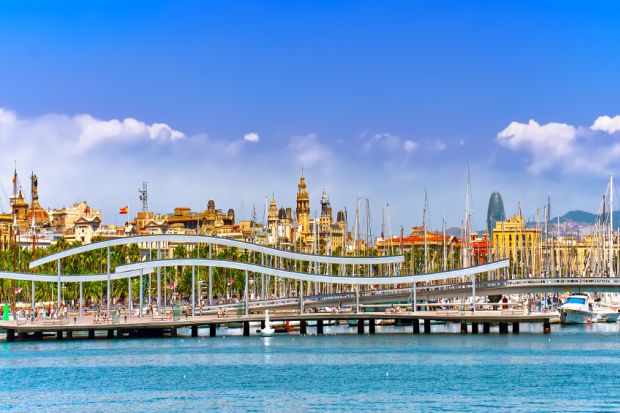Unlike many Olympic cities, Barcelona is still reaping the rewards of hosting the world’s top sporting event almost 25 years ago.
Those games in 1992 are widely credited as the catalyst for the transformation of Spain’s second largest city from an ailing industrial centre into one of Europe’s trendiest metropolises, offering a mix of art, culture, sun, sea and luxury to millions of well-heeled visitors each year. About 8,000 rooms and apartments are available in Barcelona on Airbnb alone – an indication of the incredible popularity of the once down-at-heel city.
One element of the Olympic legacy not often discussed is the formation of Pompeu Fabra University, situated at the heart of the former Olympic village, which hosted this week’s Times Higher Education Young Universities Summit, attended by delegates from 30 different countries.
Opened in 1990, Pompeu Fabra’s swish new campuses helped to breathe new life into the once-shabby end of Barcelona: its main campus occupies the site of an old military barracks where conscripts once trained, while about 1,000 scientists and other staff are housed in the stunning modernist opus overlooking the beach that is Barcelona Biomedical Research Park. Many of Pompeu Fabra’s researchers and lecturers live in apartments that once hosted Olympics athletes, just a few minutes’ walk from the lively cafes and bars of the Olympic port, while its 15,000 or so students inject life and vibrancy into the area each day.
But its role in regenerating an area once dominated by ugly railway sidings is just one part of the success of Pompeu Fabra. It is now ranked second highest in the whole of Spain, taking 15th spot in the 150 Under 50 Rankings, released this week, and 164th overall in our World University Rankings. That is bettered only by the much larger Autonomous University of Barcelona – which is 12th in this year’s 150 Under 50 list – although it has the advantage of being some 22 years older than its upstart neighbour.
Indeed, Pompeu Fabra does far better rankings-wise than many of Spain’s older and more prestigious universities; for instance, the University of Salamanca, which was viewed by many as the world’s top university in the 16th century, is ranked at between 501st and 600th overall.
These larger, older universities are a bit like “huge transatlantic cruise liners” compared with the smaller, more agile vessel of Pompeu Fabra, said Angel Lozano, its vice-president for research. “These institutions are too big and too old to change direction quickly,” said Professor Lozano, who believes that the university’s youthful set-up has helped it to sidestep some of the more restrictive Spanish red tape that has stifled innovation and change.
As such, Pompeu Fabra – named after a highly regarded Catalan language expert – is the embodiment of what a young university can achieve in a relatively short time: urban renewal, research excellence and the education of new students.
Our conference heard other inspiring stories about the success of other young universities. Yeon Cheon Oh, president of South Korea’s University of Ulsan, established by automobile manufacturer Hyundai in 1969, explained the university’s dizzying array of industrial links; while Dublin City University, established in 1975, has been central to many of the Republic of Ireland’s ties to high-tech multinationals such as Microsoft, Facebook and Siemens.
In the UK, many young universities – defined as those under 50 years of age – are putting industry engagement at the heart of their offer; and some, such as the universities of Buckingham and Portsmouth and Coventry University are outscoring more prestigious institutions in student satisfaction scores and other similar indicators.
That success is not based on simply copying the formula used by older universities, university leaders told the conference.
Peter Coaldrake, vice-chancellor of Queensland University of Technology, established in 1989 and the host of next year’s Young Universities Summit, said that seeking to emulate his institution’s older neighbours would only result in QUT’s becoming a “pale imitation” of its rivals. Instead, bold, sometimes controversial decisions were taken to help forge a new identity. The arts faculties were closed, as was their campus, replaced by a new creative industries faculty, while Coaldrake has shied away from opening a medical school, arguing that the belief that this will confer prestige and privilege on a new university is misplaced.
There were many other examples of young universities working from a different playbook from those used by the established research-intensive university, with some now competing with the old elites by playing to different strengths.
In Pompeu Fabra’s case, they have surpassed more historic and prestigious neighbours and are increasingly looking to compete on the international stage.
That is quite some legacy, and one that universities seeking to populate the eerily desolate Queen Elizabeth Park in East London – so desperately in need of some post-Olympic purpose – might follow.
Register to continue
Why register?
- Registration is free and only takes a moment
- Once registered, you can read 3 articles a month
- Sign up for our newsletter
Subscribe
Or subscribe for unlimited access to:
- Unlimited access to news, views, insights & reviews
- Digital editions
- Digital access to THE’s university and college rankings analysis
Already registered or a current subscriber? Login









